Adapted by Jane Rozum, Douglas County Extension, from the CO-Horts blogoriginally authored by Tony Koski, CSU Extension Turf Specialist.
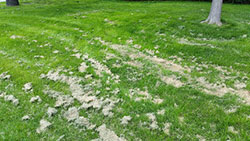
Lush, water- and fertilizer-fueled grass growth is often light green or yellow. Clippings should be collected if you can’t mow often enough to prevent the accumulation of clumps – which cause the grass underneath to turn even brighter yellow! |
What does high precipitation do to the lawn?
High precipitation and cool weather may create some temporary problems for our cool-season lawns. Persistent moisture encourages ample growth, especially on well-fertilized lawns. This growth may be lighter green or even yellow. Fast- growing grass leaves are often lighter green because leaf chlorophyll content is less concentrated or “diluted” by the rapid growth rate. Plus, those leaves lower in the canopy are normally more pale green – or even slightly yellow – than leaves higher up in the canopy, where light intensity is greater. When weather delays mowing and the grass becomes tall, the darkest green leaves are mowed off – leaving the pale green and yellow leaves behind. When high precipitation times stop, temperatures warm and mowing resumes, growth will slow and a normal color will return.
What is iron chlorosis?
The wet, cool conditions can also cause iron chlorosis to develop. The roots can’t get adequate iron from the soil to supply the rapidly growing shoots – so the turf becomes iron-deficient and chlorotic (yellow). With iron chlorosis, the YOUNGEST, newest leaves at the top of the grass plant will become deficient first. This is in contrast to the yellowing described above, which occurs on the OLDER leaves in the lower part of the turf canopy, with the youngest leaves at the top of the canopy being darker green. Persistent, severe iron chlorosis can cause the entire plant to become yellow, sometimes to the point that some plants die and the turf thins out. When soil temperatures warm and the weather is drier, the iron chlorosis will diminish.
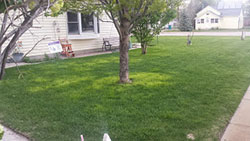
Iron chlorosis develops in random patches. The youngest leaves will be the brightest yellow, since iron doesn’t move well from older leaves to younger ones. Rapid growth and saturated soil will encourage this temporary iron deficiency in turf. |
What is melting out in bluegrass?
Melting out (Bipolaris sorokiniana) in bluegrass lawns can occur during cool, wet weather conditions as well. This fungus causes small brown spots to form on leaves and leaf sheaths. Under ideal (cool, wet) conditions, the fungus invades crowns, rhizomes and roots of the grass plant – causing leaves to turn light green or yellow. Heavily infected plants die and turn brown. The turf yellows and thins out in patches – hence the name “melting out”. Severe melting out can cause large, irregularly shaped patches of dead turf. Advanced melting out is very difficult to control with fungicides. This disease is more common on older lawns; overseeding with newer, more resistant bluegrass cultivars is probably the most effective management tool. Also, heavy spring nitrogen use will increase the potential for and severity of this disease.
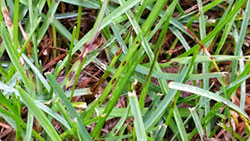 | 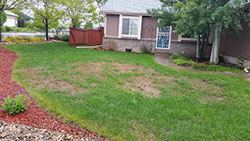 |
Melting out disease can become a big problem in bluegrass lawns during extended rainy, cool periods in the spring. Melting out can quickly kill large patches of turf when conditions are favorable: cool, moist and cloudy. |
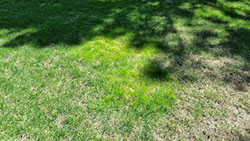
Annual bluegrass (Poa annua) invasion is favored by cool, rainy weather. |
Which light grasses are encouraged by rainy weather?
Rainy, cool weather also encourages the growth of two light green grasses in lawns: annual bluegrass (Poa annua) and roughstalk bluegrass (Poa trivialis). Poa annua grows and flowers profusely in early spring and Poa trivialis will spread rampantly in this kind of weather. Selective control of Poa trivialisin bluegrass lawns is not possible; annual bluegrass can be controlled long term using a combination of strict cultural practices and use of Tenacity (mesotrione) herbicide.
For more information:



